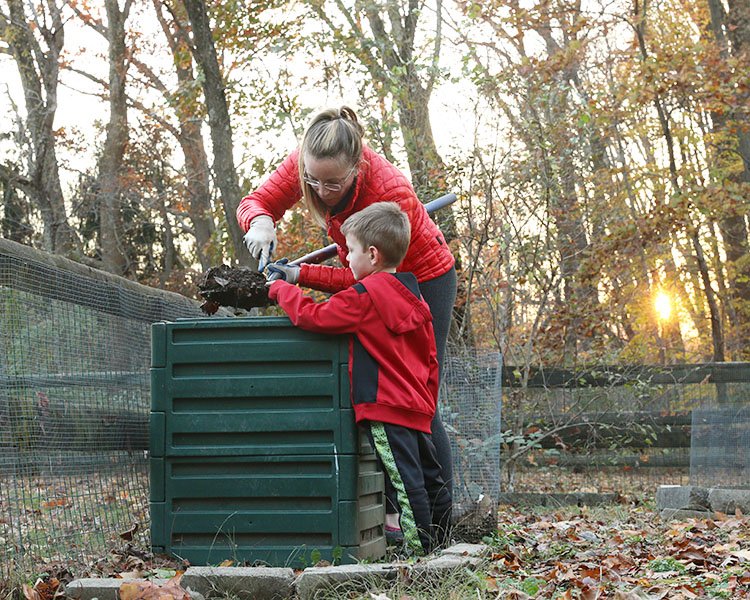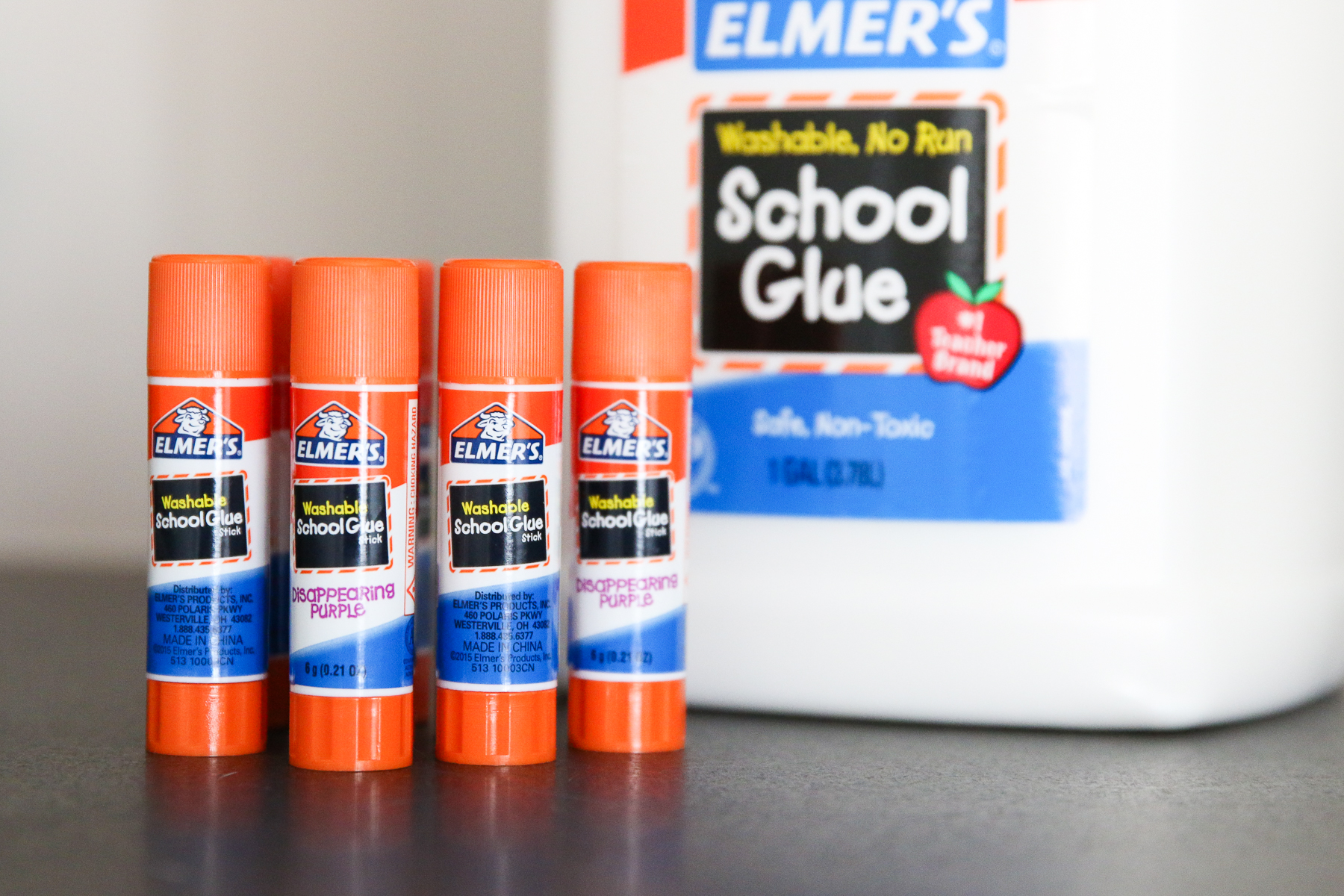7 Simple Tips to Prevent Kitchen Compost Bins from Smelling
Curious about composting but worried about food scraps making your kitchen stink? Think again. With a few simple tips, you can manage compost scraps in your kitchen so they don’t smell or attract insects. Read on for more details about how to prevent kitchen compost bins from smelling.
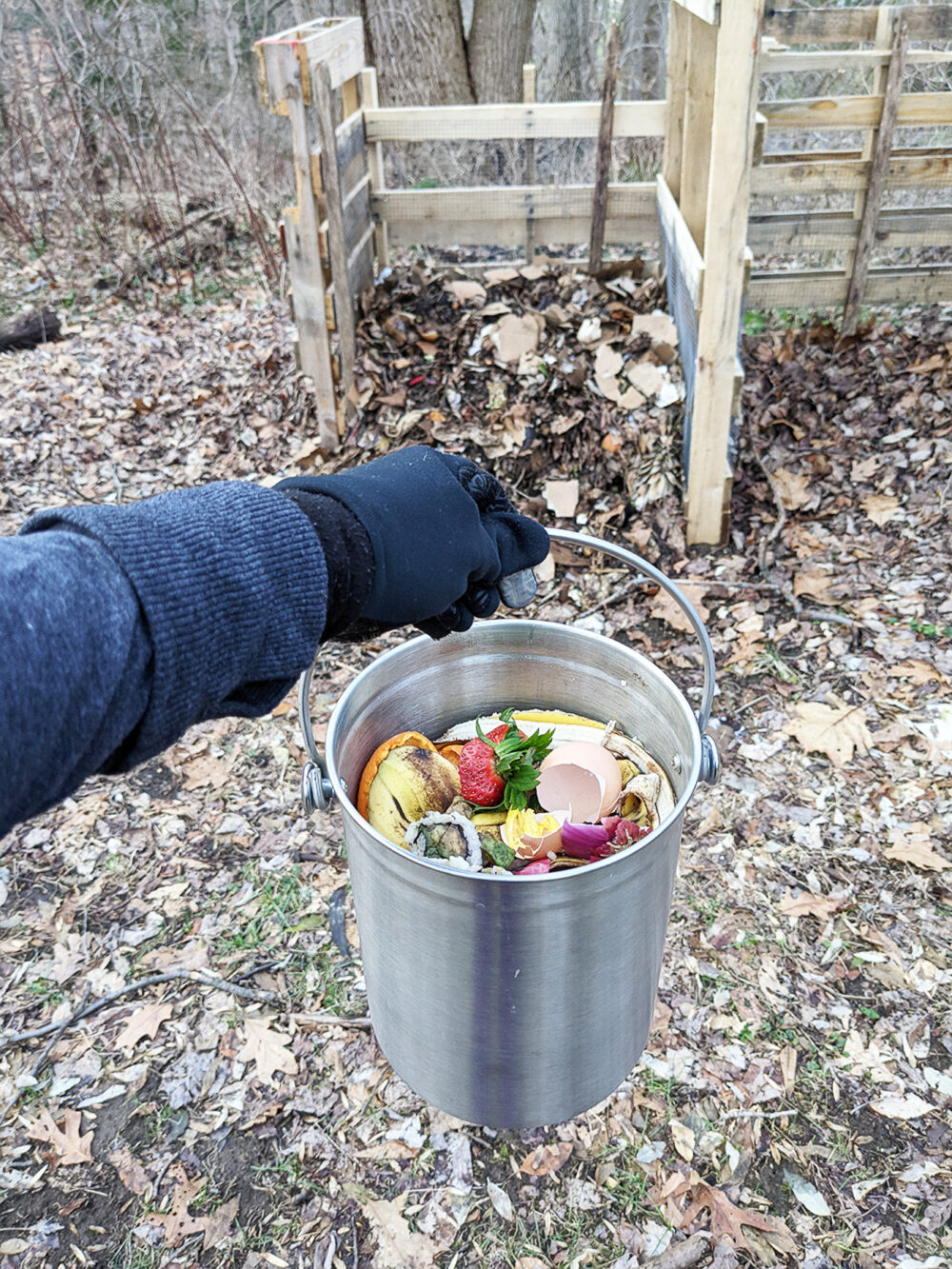
This post contains affiliate links.
By far one of the biggest hesitations I hear about composting is the fear of a stinky kitchen infested with fruit flies. Many people are concerned that collecting their food scraps in a countertop bin will become a breeding ground for stinky rotting food, ant colonies, and fruit flies.
But let’s step back for a minute and compare a compost bin to our kitchen trash can.
- Do we put food scraps in our trash bins? Yep!
- Do we put a top on our trash bin? Sometimes, but definitely not always.
- Do our trash bins become disgusting breeding grounds for stenches and insects? Nope (assuming they are managed responsibly).
Our trash bins are no different than countertop food scrap bins when we manage them properly. In fact, I’d argue that well-managed countertop compost bins actually do a better job of keeping out the pests and smells because that’s precisely what they’re designed to do.
As a side note, you may not even need a kitchen compost bin to collect food scraps if you plan to compost. There are lots of ways to store food scraps other than housing them in a countertop bin (freeze them, keep them in a bowl and take them out to the compost heap daily, and more). But if you do plan to store them in a collection bucket, there are a few tips to make sure those scraps don’t stink up your kitchen.
7 Simple Steps to Prevent Your Compost Bin from Smelling
If the “gross factor” of composting has been keeping you at bay from diving into this amazing, regenerative, important habit, have no fear. A little education and the right tools can make all the difference. Let’s dive into a few simple tips and tricks to prevent your compost bin from stinking up your kitchen.
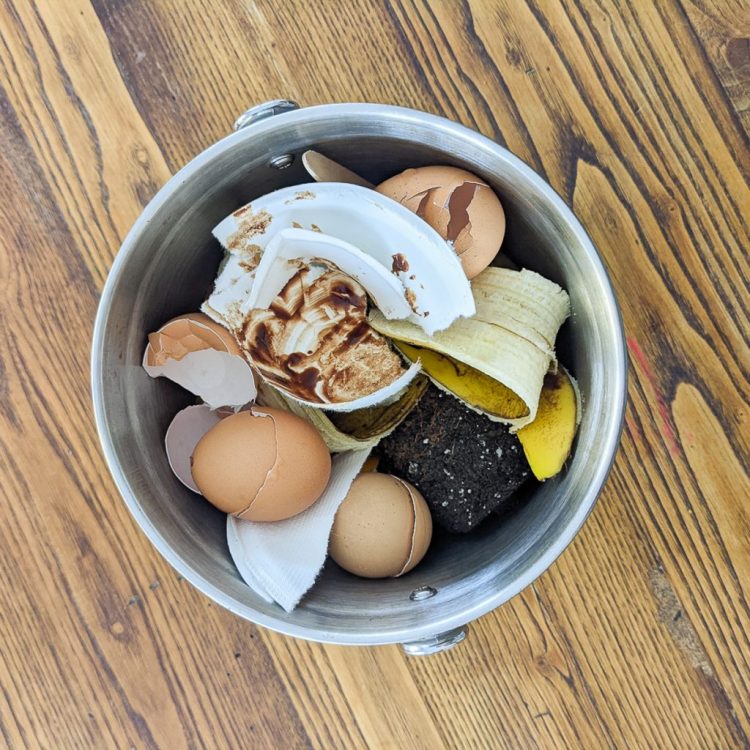
Choose the Right Kitchen Compost Bin
When it comes to preventing odors in your kitchen compost bin, selecting the right bin is crucial. Countertop compost buckets are designed to fit seamlessly into your kitchen workflow. These small, stylish bins facilitate the collection of kitchen scraps and minimize odors.
I have used a few different bins and the ones by Natural Home Brands are my favorite. They have a lighter-weight stainless steel option and heavier ceramic alternatives. There are plenty of good options out there, but these are my favorite because they have all of the qualities mentioned below.
I did not like the Simplehuman compost caddy. It’s pretty and attaches to a trash can, but it does a very poor job of managing odors. Also, the food waste stained the inside of the plastic container. At the time, I wasn’t using compostable liners, and those might have helped keep the compost caddy cleaner. But even despite that, it’s not my favorite container if you’re in the market for one.
Here are a few qualities to consider when looking for the right countertop compost bin:
- Tight sealing lid: Focus on bins with lids that can tightly seal. A tight-fitting lid will help contain unpleasant smells within the compost bin, so you won’t have to worry about unwanted odors escaping into your kitchen.
- Charcoal filter slots: Look for compost bins that have built-in odor control mechanisms, such as charcoal filters, which help absorb smells before they have a chance to escape. This can go a long way in keeping your kitchen smelling fresh and maintaining a pleasant environment. Remember to replace these filters regularly according to the manufacturer’s recommendations. Typically they need to be replaced every 3-6 months.
- Bin construction materials: In addition to sealing and odor control, think about the materials used to construct the bin. Stainless steel is a popular choice because it’s easy to clean and resists absorbing odors. I also like bins made of ceramic, if you’re interested in something sturdy that also has more aesthetic appeal. Alternatively, look for bins made of durable plastic with smooth, rounded walls which are also easy to clean and can help reduce the chance of lingering smells.
- Appropriate size: Think about how often you want to empty the bin and how quickly you will fill it. Choose a bin that will hold food scraps for a few days (or maybe up to a week, at most). You don’t want the food scraps to sit on your counter for much longer than that or they may start to become a problem (much like trash sitting in your trash can for too long).
- Easy to carry: If you’ll be carrying your food scraps to an outdoor bin or collection area, consider choosing a countertop compost bin that’s easy to transport. Many models come with convenient handles, making it simpler to bring the compost bin outside once it’s full. Stainless steel and plastic kitchen compost bins will generally be lighter than ceramic alternatives.
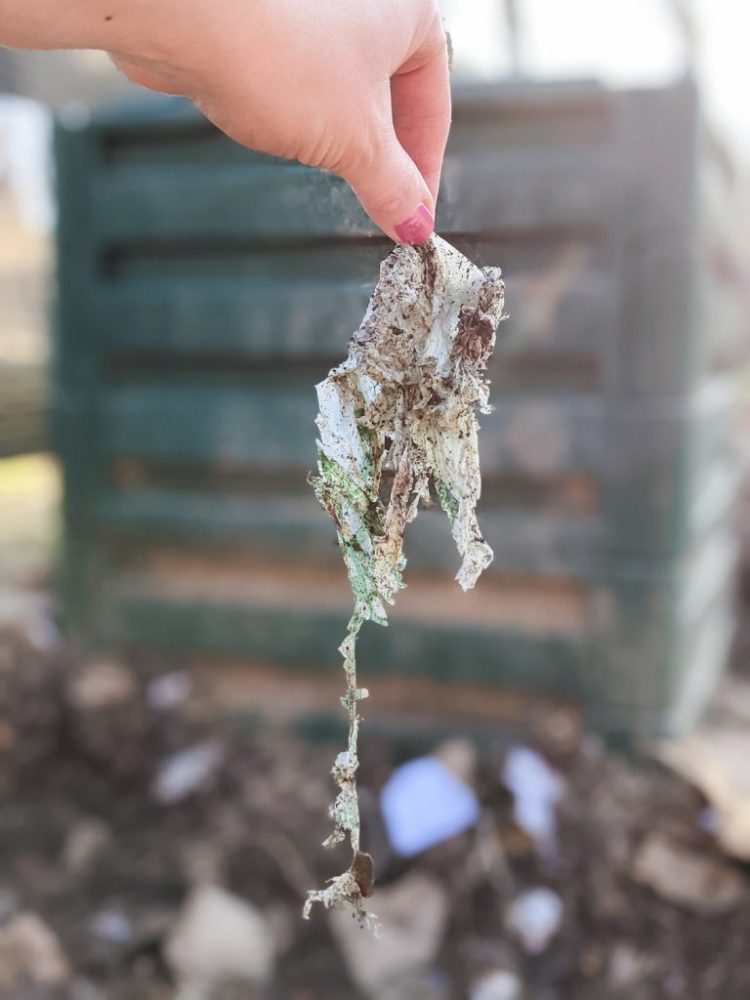
Add a Compostable Liner to the Bucket
Do you use a trash bag in your kitchen trash can? Does it help keep your trash bin and trash tote a whole lot cleaner? Of course it does! And a kitchen compost bucket isn’t any different.
By using compostable liners, you create an extra barrier between the bin and the decomposing waste, which helps contain possible smells. Plus, they make it easy to transfer your compost from the countertop bin to your outdoor compost pile or collection bucket, without having to clean the bucket every time.
Adding compostable bags as liners is definitely not required. For years, I used a stainless steel countertop bin, tossed scraps right into the bucket, and emptied them periodically into my compost pile. Then I washed the countertop bucket with soap and water after each use. However, the liner does make a big difference if it’s important to you.
Compostable Bioplastic Liners: Often green-colored, compostable liners are the best options for lining your kitchen compost bin. While I prefer brown paper bags for larger compost buckets, the bioplastic liners offer the most flexibility inside a kitchen compost bin and can be tied closed when full. I think this is the easiest way to line a small kitchen compost bin.
Remember that these compostable liners are meant to break down, so they do start to decompose over time particularly if they get really wet. I don’t generally put heavy liquids like dairy products or leftover oils in the kitchen bin because they will make the compost bin pretty messy. However, I regularly add bits of cheese or cooked vegetable remnants even if they’ve been cooked in oil or grease.
Certified Compostable Liners
If using a compostable plastic liner, make sure that it’s certified for composting and breaks down properly according to the facility’s regulations. My favorite compostable liners are from BioBag, but there are lots of options on the market.
Look for the certification that identifies it as either home compostable or commercially compostable. If you’re composting at home, make sure the bag is home compostable (i.e. backyard compostable). If you’re composting with a commercial facility, be sure they accept compostable bioplastics.
It’s also worth noting that compostable liners and other compostable bioplastics, even if they break down in a backyard bin, will take much longer to decompose than the rest of the organic matter. Be sure to tear open the compostable liners before you put them in your backyard bin so the contents inside and the bag both break down more quickly.
Related Reading: Everyday Kitchen Items: Home Compostable vs. Industrial Compostable
Brown paper bags: Brown paper bags are also compostable and will be great for lining your kitchen compost bin too. You can use small brown lunch bags or even repurpose small brown paper shopping bags you might have picked up along the way of life. These don’t fit as nicely into the countertop bin, so they aren’t my favorite. But they are a perfectly suitable option if that’s what’s most available and accessible to you.
Plastic liner bags: These are a big no-no. Plastic is not compostable. Unless it’s bioplastic and says it’s compostable, plastic bags are not great liners. You could use them as liners if you plan to toss the food scraps into a collection bin without the plastic bag. But the plastic bag cannot go into a compost pile or system. It will contaminate the compost.
Using a liner can keep your compost bin clean and prevent the buildup of unpleasant smells. When you’re ready to empty your compost bin, simply remove the liner and dispose of it in your outdoor compost pile, municipal composting facility, or other larger collection bucket.
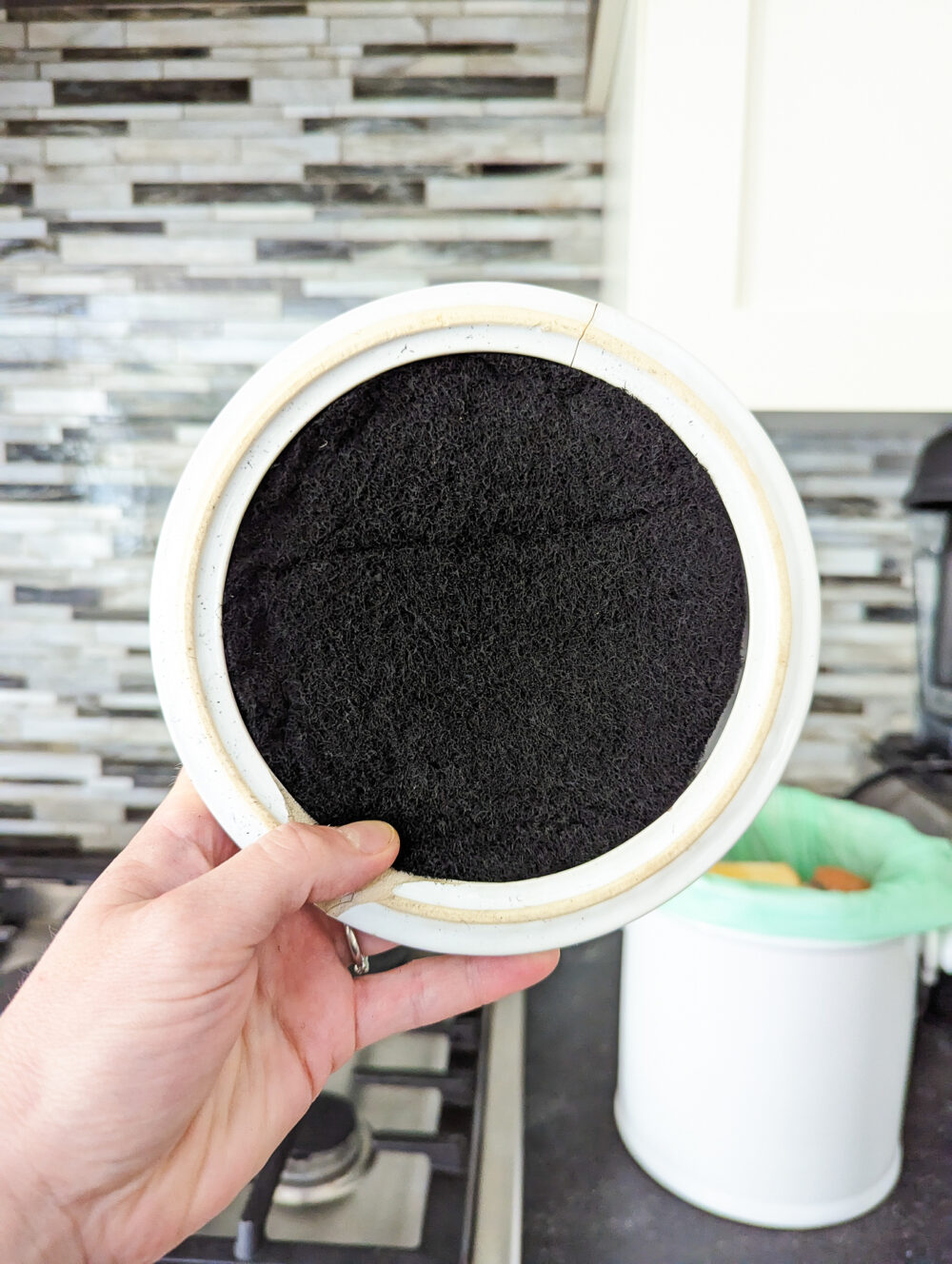
Use a Charcoal Filter Inside the Lid
One effective way to prevent your kitchen countertop compost bin from smelling is to use a charcoal filter inside the lid. A charcoal filter works by absorbing and trapping odors emitted by food scraps over time, helping to maintain a fresh-smelling environment around your compost bin.
When selecting a compost bin for your kitchen countertop, opt for one that has a built-in compartment at the top to hold the charcoal filter. The presence of this feature will make it easy for you to incorporate the filter, helping to minimize unpleasant smells from the get-go.
Remember that charcoal filters need to be replaced periodically to ensure they remain effective at trapping odors. Generally, it is recommended to replace your charcoal filter every three to six months. However, if you begin to notice that your compost bin is starting to emit an odor before that time has passed, it may be a good idea to replace the filter sooner.
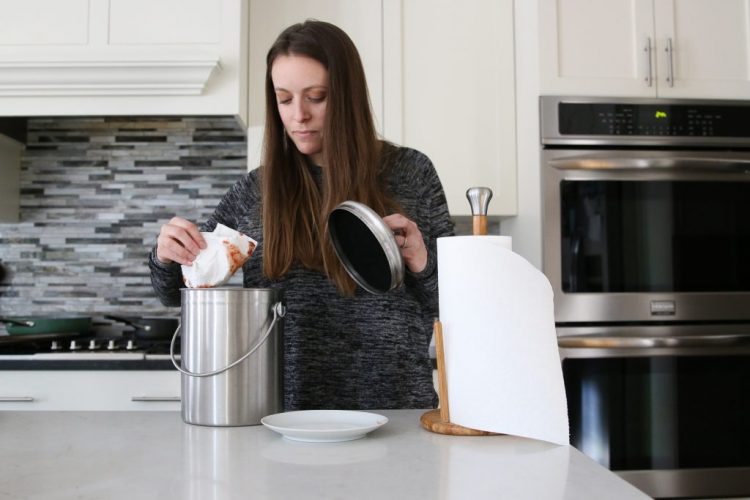
Add Paper Products to Manage Moisture
If you’re noticing that your kitchen compost bin is starting to get a little too wet but it’s not yet full, adding paper products (i.e. compost brown ingredients) can help absorb excess moisture and control odors. Materials like shredded newspaper, dirty paper towels, paperboard egg cartons, or ripped-up cardboard help absorb excess liquids, and this makes it easier to manage any foul odors and makes the compost bin less attractive to fruit flies and ants.
When adding paper products to your compost bin, it’s important to make sure that those paper products are also compostable. Ensure that your paper products are clean and uncontaminated. Avoid materials with glossy finishes as they may not be suitable for composting.
Related Reading: 9 Types of Free Compost Browns
Empty Bucket Regularly
One of the most effective ways to prevent your kitchen compost bin from smelling is to empty it regularly. With consistent emptying, you can minimize the buildup of food waste and reduce the chances of odor development.
We empty our countertop compost bin every 3-5 days in the winter and maybe every 2-3 days in the summer. How often you empty it will depend primarily on how fast you fill it up. But if you let it sit in the bucket for too long, it may start to smell. It’s sounding a lot like a regular trash bin again, huh?
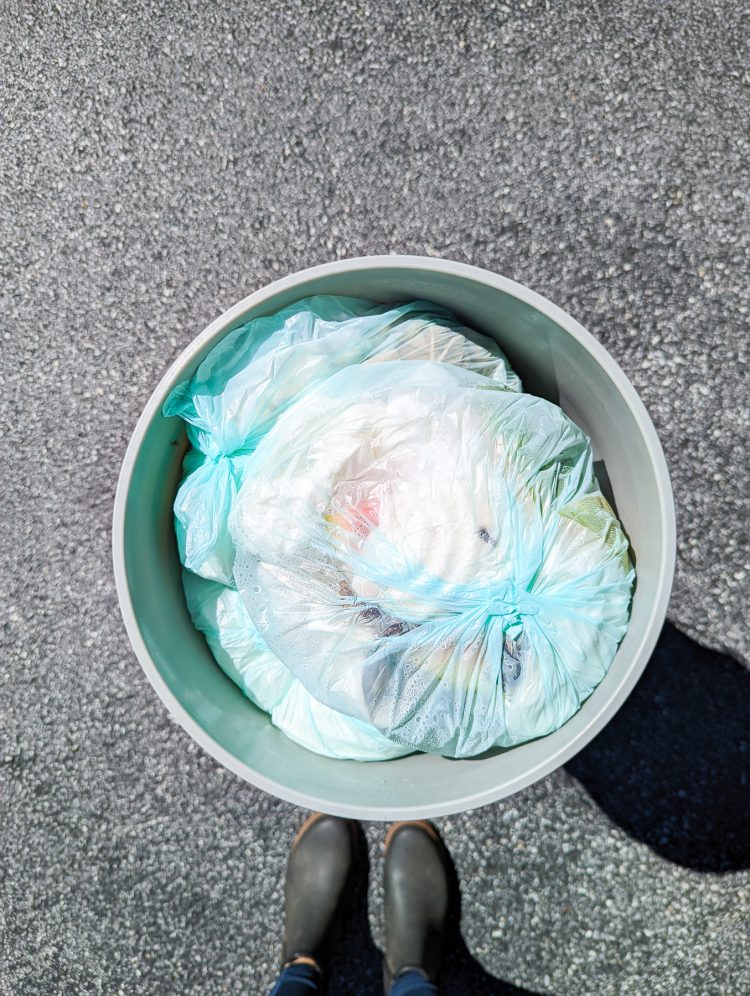
Tie Liner Bag Closed When Full
If you’re emptying the kitchen compost bin on your counter to move it to a larger collection bucket (like a curbside collection bucket or municipal collection bin), tie the liner bag closed when it’s full. This helps to keep smells in and prevent the larger bucket from becoming a hot mess (pun intended).
When it’s time to empty your compost bin, remove the bag and securely tie it shut by tying the bag in a knot. Do not use anything like a plastic twist-tie, a rubber band, or another item that’s not compostable. Tying it shut helps the management of the contents, but plastic, rubber, or other tying mechanisms will contaminate the compost heap.
If you compost at home and you’re simply taking the food scraps from your kitchen to your own outdoor bin, do NOT tie the bags closed. It’s much easier for the items in the bag to decompose quickly when the microorganisms in the compost bin can get to them directly instead of having to work through the compost bag first.
Clean the Bucket
Keeping your kitchen compost bin clean is essential for preventing unpleasant odors. A regular cleaning routine will help maintain a fresh and hygienic environment in your kitchen. Here are some steps to follow:
- Rinse your compost bin after each use. Emptying your bin regularly will help to minimize any lingering smells. Once you’ve removed the contents, give the bin a quick rinse with water to remove any remaining residue.
- Clean the bin with soap and water as needed. Depending on how often you use your compost bin, it may require more frequent cleaning. Use warm soapy water to remove any built-up grime and organic matter. Be sure to scrub all the surfaces, including the lid and any interior crevices, to ensure thorough cleaning.
- Allow your bin to dry. A dry bin helps to prevent mold growth and keeps odors at bay. Leave the lid open to allow for proper air circulation, or place the bin in a well-ventilated area to speed up the drying process.
Add Odor-Absorbing Materials
Finally, you can incorporate odor-absorbing materials directly into your compost bin, such as baking soda, charcoal, or even a few drops of essential oils like lemon or tea tree oil. These substances will help mask and neutralize the smells produced by the decomposition process. I have not needed these in the past, but I am sure they could be a nice addition if they helped make composting easier or more amenable.
Related Reading: Can I Compost…? Interactive Chart
A note on free countertop buckets from municipalities
In the United States, a growing number of municipal organizations are mandating composting or making it more accessible to their residents through a variety of different programs. As part of the effort, many municipalities provide free countertop food scrap buckets to residents. These are often plastic and do not have charcoal filters.
If you receive a free bucket like this, know that it’s just fine. You don’t need the “Rolls Royce” of compost bins if you have something available to you for free. Using a liner, emptying the bin regularly, and washing it after each use goes a long way in keeping the bucket clean and preventing smells or insect infestations around the food scraps.
Ignore the Fear-Mongering Marketing
Companies that stand to profit from fear of food scraps in your kitchen, like those selling electric composter machines, might lead you to believe that a traditional organic waste bin in your kitchen is your worst nightmare. Let’s look at an example of this misleading messaging. The image below is from Lomi’s marketing page for their “magic composting machine” – my words, not theirs – (hint: it’s not magic at all, I’m not a fan of it for the masses).
They’re very clearly implying that a green waste bin will attract pests, leave smells and messes, be difficult to maintain, be ugly, and be wasteful. This is incredibly disingenuous marketing.
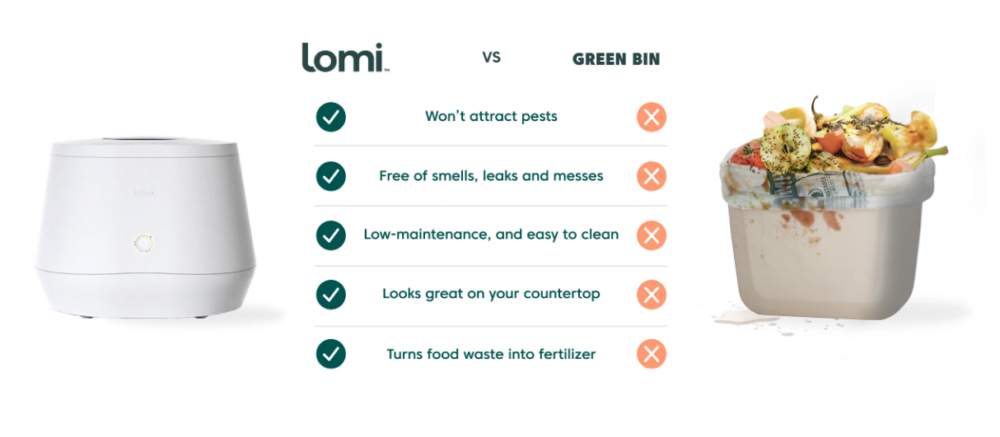
If you let your food scrap bin collect food like the photo on the right (piled up, with no top, and dripping all down the side of the bucket), of course it will be a disaster. The same would be true if you let vegetable scraps, eggshells, and other organic materials pile up in a Lomi bucket or your trash can like that! But no one concerned about stinky kitchens is leaving their apple cores, coffee grounds, and peach pits lying around in a giant mess. Here is how my kitchen counter bin looks.
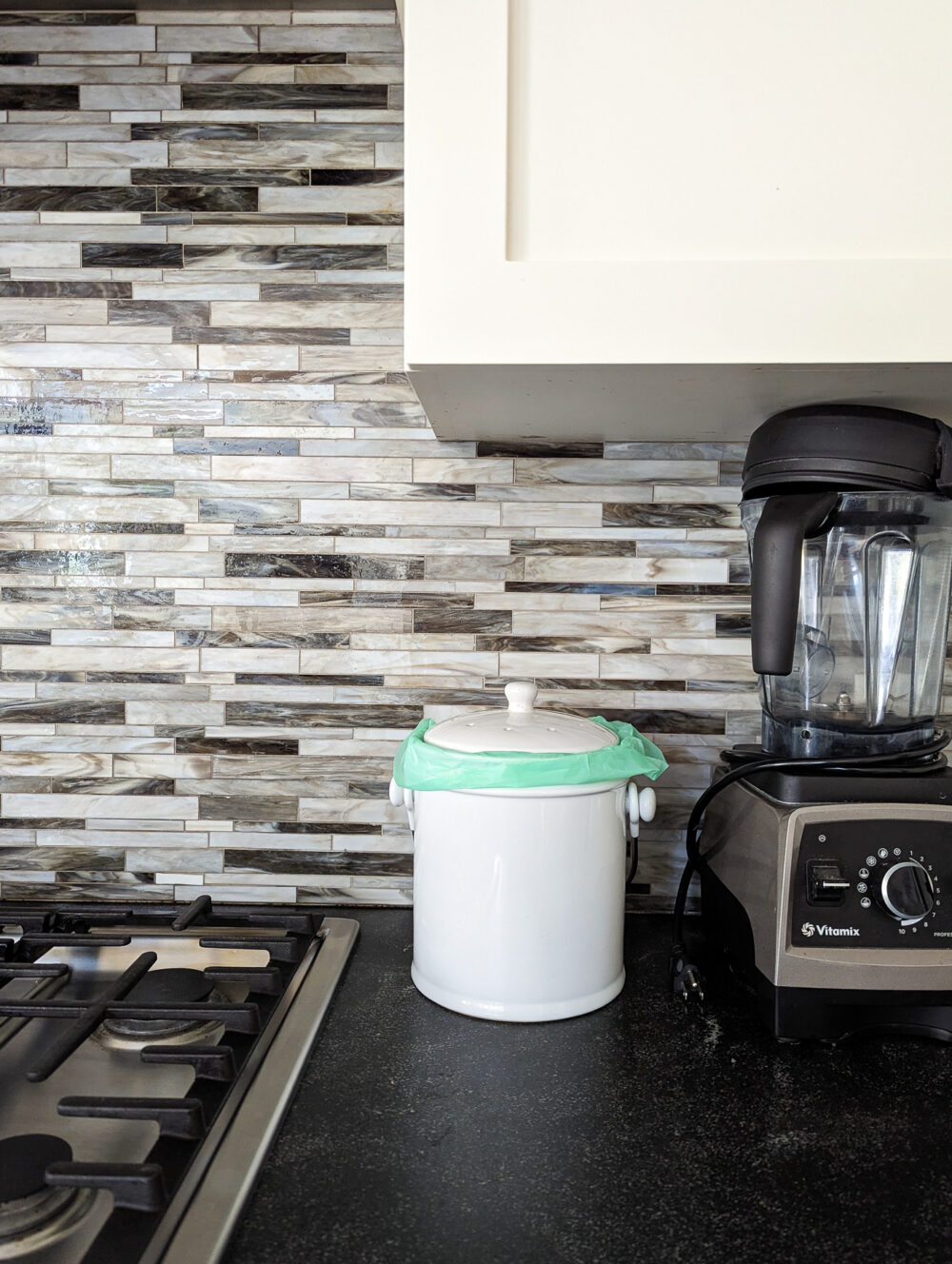
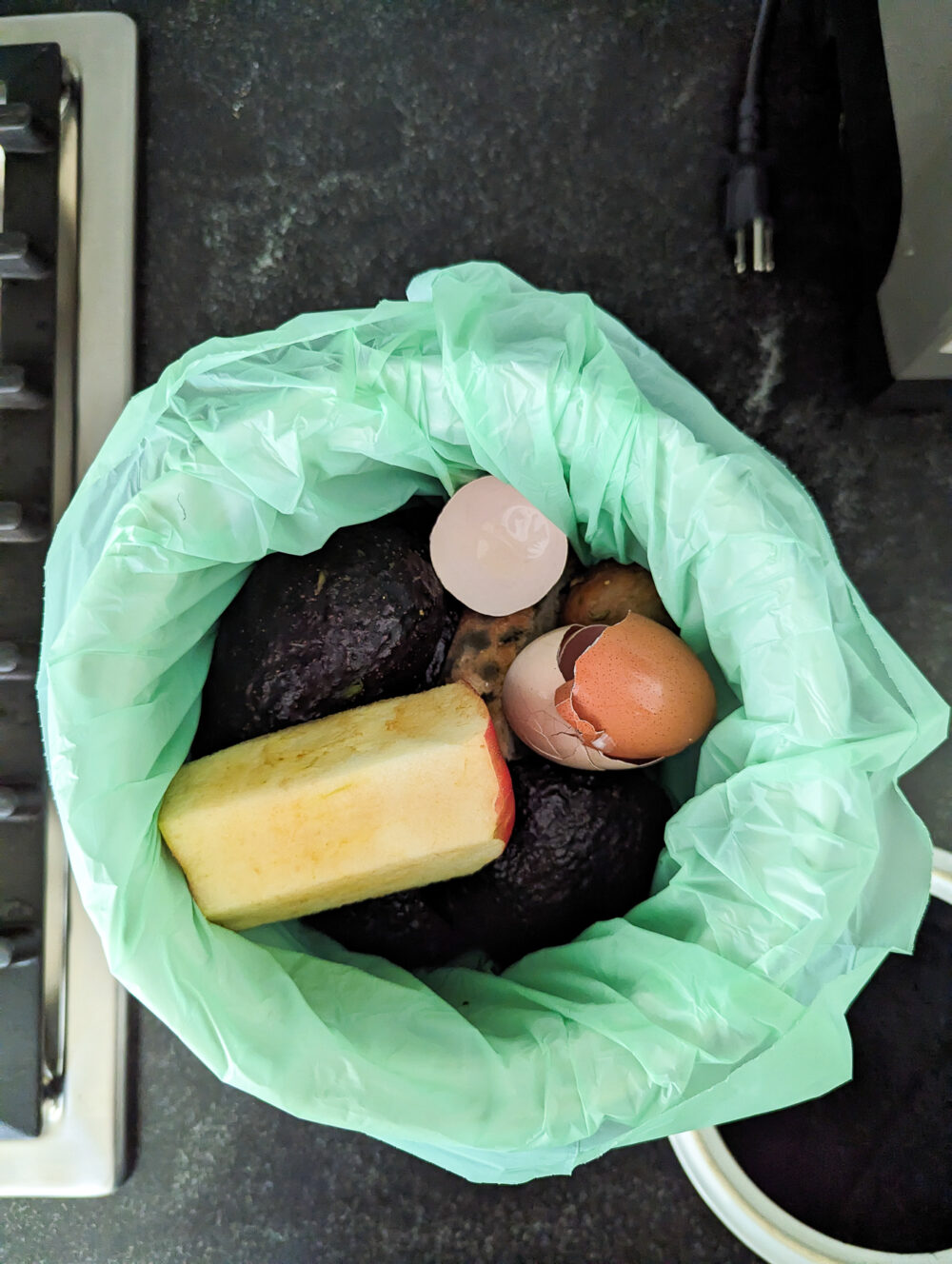
Here are the kitchen countertop bins from a couple of the people we have featured in our Compost Chronicles series. These bins are nice and clean.
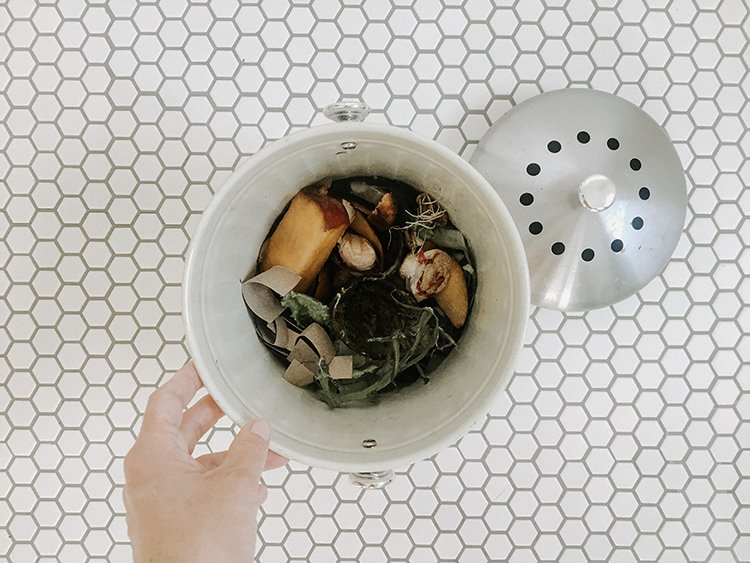
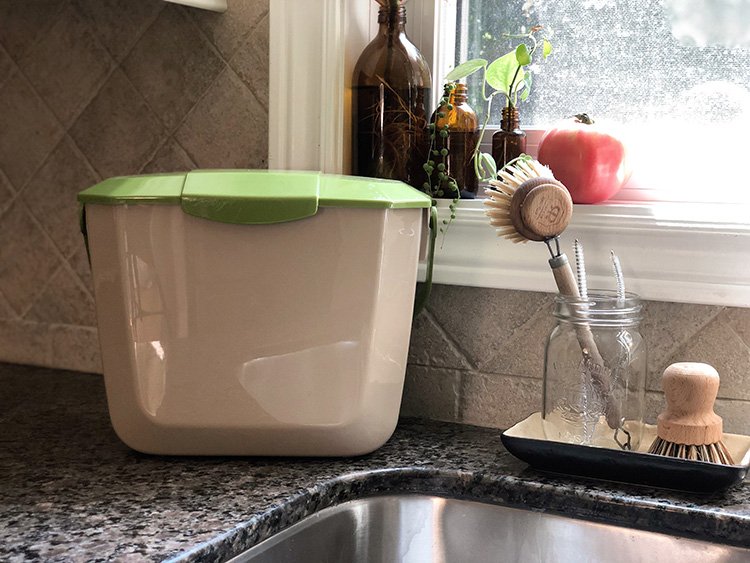
As I said at the beginning, the countertop bin is only as effective as your management of the waste – just like your trash! If you regularly take out trash and it doesn’t cause odors or insect infestations in your home, it’s unlikely a well-managed kitchen countertop compost bin will either.
So there you have it. Kitchen compost bins are only as gross as your trash bins. And there are plenty of really simple and effective ways to prevent kitchen compost bins from smelling up your kitchen or attracting all sorts of insects and pests to your home.
Do you have any other tips for odor-free compost bins? Or questions about how to keep your kitchen compost bin clean? If so, be sure to share them in the comments!
If you like this post, you might also like
6 Ways To Keep Your Curbside Composting Bucket Clean
Should I Use A Compostable Liner In My Compost Bucket?
5 Ways To Compost While Traveling + FAQ For Composting On The Road

Jen Panaro
Jen Panaro, founder and editor-in-chief of Honestly Modern, is a self-proclaimed composting nerd and advocate for sustainable living for modern families. To find her latest work, subscribe to her newsletter, Stepping Stones.
In her spare time, she’s a serial library book borrower, a messy gardener, and a mom of two boys who spends a lot of time in hockey rinks and on baseball fields.
You can find more of her work at Raising Global Kidizens, an online space to help parents and caregivers raise the next generation of responsible global citizens.




